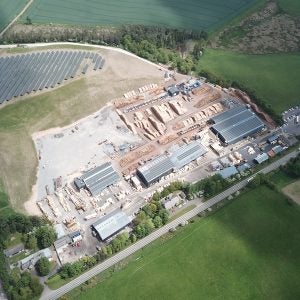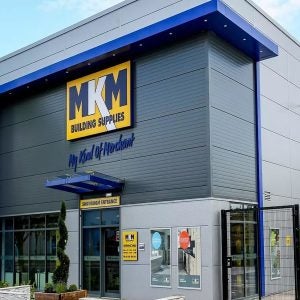The decision to kick off the Trussed Rafter Association’s AGM this year with a young mountaineering motivational speaker perhaps is a good illustration of where the TRA is at currently.
With large images being projected onto a big screen of Mt Everest– which speaker Mollie Hughes climbed at the age of just 21 – the tone was clearly set. Onwards and upwards, striving for excellence and achievement and being prepared to meet challenges on the way was clearly what the TRA is setting out to do with a renewed sense of purpose and vigour.
The AGM near Leicester was attended by about 80 people, made up of manufacturers and suppliers to the sector.
TRA chairman Jonathan Fellingham and his colleagues outlined a wide array of initiatives the organisation is working on. He said TRA members currently had a 69% market penetration in the trussed rafter market. And in the past two years 16 new members had joined the association.
The TRA’s aim was to get 85% of the trussed rafter and metal web joist manufacturing industry in TRA membership Mr Fellingham said there was increased emphasis on the TRA providing product design, installation and procurement guidance.
“Leaving it to builders does not wash with builders anymore,” said TRA chairman Jonathan Fellingham.
This work will involve more regular workshops and refining work by TRA technical and safety committees.
Along with R&D work, a new website and appointment of a new PR company, this would mean greater TRA expenditure. “The TRA’s reserves are going to be eaten away in the next 12 months because of hiring a new PR company and R&D work,” said Mr Fellingham. So, a small increase in TRA subscription rates will be made.
Challenges include construction sector skills shortages and a loss of market share to advanced panelised roofing systems.
New TRA Ireland group
A New TRA Ireland group has been formed, with seven members already from the Republic and Northern Ireland, including Armstrong Timber Engineering, ATS Trusses Ltd, Cork Roof Truss Company, Harmony Timber Solutions Ltd, Magtruss and Quinn Building Supplies.
The group is now liaising closely with HomeBond, the leading provider of structural defect cover for new homes in the Republic of Ireland, to ensure guidance on metal web joists and trussed rafters is updated in its House Building Manual, often referred to as the Blue Book.
The Ireland group aims to become the leading authority on timber trussed rafters and metal web joists for the relevant authorities such as HomeBond, the National Standard Authority of Ireland and Building Control Northern Ireland.
Another major development has been the TRA and Structural Timber Association (STA) signing a memorandum of understanding to reinforce the close working relationship between the two bodies.
They are currently working with regulatory organisations and new build warranty providers including the NHBC to develop endorsed technical guidance for spandrel and gable panels, and will be working on updated codes of practice for timber roof and floor construction.
Other initiatives will include agreeing a common approach to fair payments throughout the supply chain, targeting activity to attract new talent into the engineered wood industry, combined lobbying on apprenticeships, and options for a shared CPD (continual professional development) framework to boost industry skills and knowledge.
“What matters now is that we can grow the market for timber products through sharing our knowledge and collaborating on research and technical development on areas such as fire safety, site practice and construction safety,” said Mr Fellingham.
TRA/STA labelling of spandrel panels for ease of NHBC surveying and assurance to builders is moving forward.
Solutions are being fire-tested in conjunction with the STA in Q2 at the BRE. Gable panel detailing was submitted to NHBC in April.
The NHBC endorsement for all TRA/STA spandrel & gable details is hoped to be in the NHBC’s technical extra update in the summer. BIM standards for trussed rafters and metal web joists are another focus of attention. A trussed rafter installation guide has been drafted and will eventually by something the industry can distribute to its customers. The guide also intends to look at hip ends and attic trusses.
Other news at the TRA AGM was the appointment of Liz Male Consulting as the organisation’s new PR company, which will oversee development of a new website, a TRA YouTube channel, a marketing toolkit for members and social media focus.
Ms Male said only 64% of supplier members mention TRA on their websites and only 33% link back to the TRA website.
Since the current website went live in 2013, 52,752 UK users have been recorded, with attic trusses being the most visited section over the last year and 25% of visits being from mobiles/tablets.
On the training front, the trussed rafter industry has been setting out new initiatives to tackle skills shortages.
The TRA announced that its online training facility, developed in conjunction with Edinburgh Napier University, would be offered free to TRA members.
The Essentials and Advanced course elements of the TRA’s course together provide about 40 hours of learning, attracting more than 40 candidates over the last two years. The joint TRA/Napier University certificate is recognised as a Scottish NVQ.
This year’s highest scoring learners in the course – Andrew Mitchell and John Collins – won a trip to Vida Wood’s Borgstena sawmill in Sweden, with Richard Thick, MD of Vida Wood UK, presenting them with their prize at the AGM.
A housebuilder’s view
Oliver Novakovic, Barratt Developments’ technical and innovation director, gave TRA members a housebuilder’s perspective. “We’re seeing skills shortages in specific areas so we are not completing the level of housing we’d like to.
“We are doing offsite because it gives us more options to deliver our 18,000 units – not just because the government wants to do it. It makes good business sense.”
Barratt’s 2020 vision is that 20% of its units will be offsite.
When asked if housebuilders would revert to their masonry mainstay in the event of a housing market recession, Mr Novakovic predicted another 2-4 years of “good times” ahead and said if off-site system development continued, users would stick with the methods because they would be so good. “It’s not about us saying let’s have these systems for a bit of fun. We’re in it for the long-term future,” he added.
Barratt had selected four panelised roofing systems from trials but admitted it would “be a while” before the company decided to use these in volumes and was “not yet for us”. Mr Novakovic also had a warning for roof truss suppliers of the need to come up to speed with Building Information Modelling (BIM).
“If you are not Revit enabled [with BIM] then I struggle to see where your future is with us.”
Speaker Mark Farmer, who penned the Farmer Review of the UK Construction Labour Model: Modernise or Die last year for the government, said the current surge of interest in innovative offsite housing technologies should not be seen as a threat to the established trussed rafter sector, he said. He said the housebuilding industry was seeking to grow capacity, with existing construction methods like trussed rafters very much part of the equation and by their nature already in the pre-manufactured category.
“I do not think we have to decouple new things from what is already being done in the industry. It’s both.”
However, he encouraged TRA members to look at further aspects of pre-manufacturing, such as roof and floor cassettes and to engage with roof covering suppliers and others to help integrate various roofing aspects to provide a more complete premanufactured solution.
“What are your customers looking for in the future?”
He highlighted the issue of construction skills shortages and quality of workmanship, with one new development in London having to be condemned.
“I think the housebuilding industry is in for a very rough ride to prove to consumers and the media that it is building the right quality homes.”
Mr Farmer said the government’s push of offsite construction would not in itself be enough to change the build landscape – the industry needed to catch on.
Some housing associations were doing just that and were seeing opportunities to bring much of the build process under their own control by entering the off-site business themselves.
Swan Housing Association’s property development arm Nu Living is setting up a CLT factory in Basildon, Essex.
Mr Farmer said Brexit was a “massive risk”, saying 25% of the construction workforce in London was migrant labour, with some building sites having up to 80% migrant labour dependency.
Mr Novakovic said 40-80% of Barratt’s workforce is migrant. “These last two years represent the first time a major builder has had skills firmly on our agenda.”
Mr Farmer advised the trussed rafter sector / timber construction sector to lobby government with the widest possible units front representing many areas of the supply chain.
“But is very difficult because it’s a fragmented industry with so many vested interests.”






